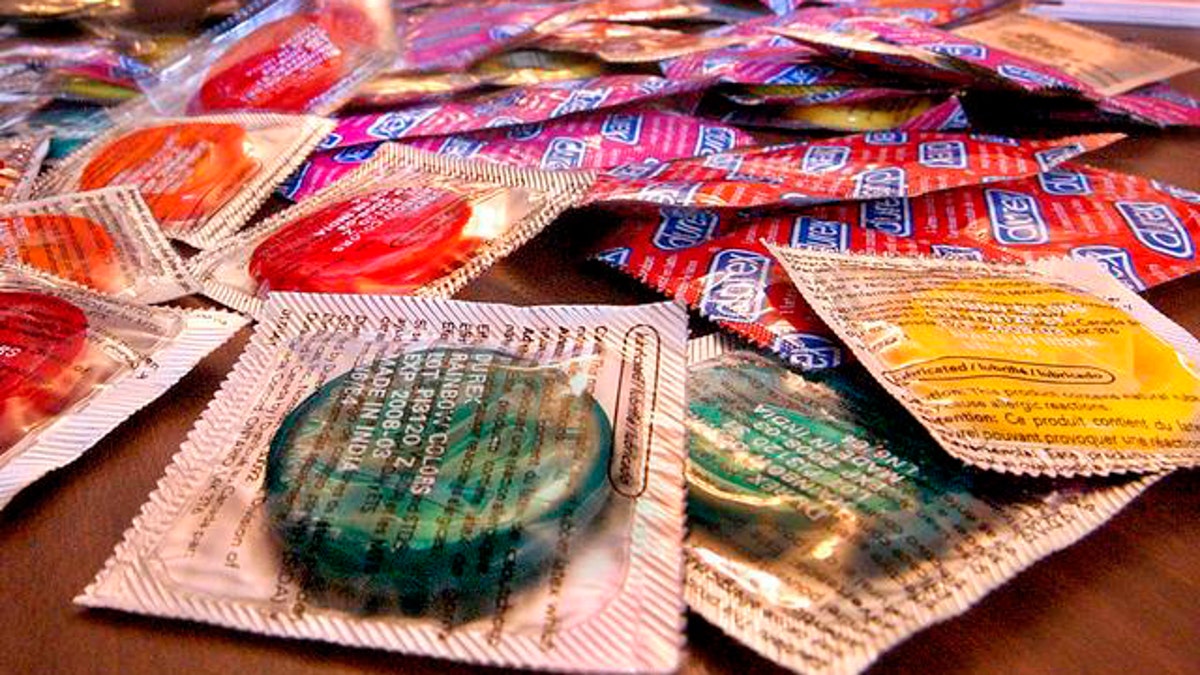
An assortment of condoms is offered for free to visitors of the Statehouse during a World AIDS Day ceremony inside the rotunda at the Illinois State Capitol in Springfield, Ill., Wednesday, Dec. 1, 2004. Some Illinois health workers have said they were disappointed that Illinois Gov. Rod Blagojevich has ordered the Illinois Department of Public Health not to buy any more condoms in bright colors or flavors like orange and cherry. (AP Photo/Seth Perlman)
The percentage of sexually active teens who use condoms has declined over the last decade, according to a new report from the Centers for Disease Control and Prevention.
In 2013, 59 percent of high school students who had sex in the last three months said they used a condom during their last sexual encounter, down from 63 percent in 2003, the report said.
The recent decline follows a period of rising condom use between 1991 and 2003, the percentage of high school students who used a condom during their last sexual encounter increased from 46 percent to 63 percent. [10 Facts Every Parent Should Know about Their Teen's Brain]
The drop in teen condom use "shows the need for continued efforts from parents, schools and communities" to educate teens about condom use, said Dr. Tom Frieden, director of the CDC.
But in what Frieden called encouraging news, the percentage of teens who are currently sexually active (had sex in the last three months) has declined in the last few decades: from 38 percent in 1991 to 34 percent in 2013.
"We still think it's too high, but at least the trend is going in the right direction," Frieden said at a news conference June 12.
The new report, which is based on surveys of more than 13,000 U.S. high school students in 2013, asks teens about a number of health behaviors.
Another finding is that texting while driving continues to be a concern for high school students, said Dr. Stephanie Zaza, director of CDC's Division of Adolescent and School Health. In 2013, 41 percent of students who had driven a car in the last month said they had sent a text or email while driving. In South Dakota, it was 61 percent, the highest in the nation among the 37 states for which researchers had data on this question.
There was positive news about youth smoking, Frieden said. In 2013, 15.7 percent of high school students said they had smoked a cigarette in the last month, the lowest rate since 1991.
"We're encouraged to see that high school students are making better choices in some areas," Frieden said. However, other studies show an increase in hookah and e-cigarette use among teens, which was not assessed in the current report.
Other noteworthy findings from the report include:
- The percentage of high school students who had been in a physical fight at least once in the last year dropped considerably over the last few decades, from 42 percent in 1991 to 25 percent in 2013.
- The percentage of high school students who drink soda daily has declined in recent years, from 34 percent in 2007 to 27 percent in 2013.
- Although a smaller percentage of students are now watching TV, more students are spending recreational time in front a computer. The percentage of students who watch three or more hours of TV on week days decreased from 43 percent in 1999 to 32 percent in 2013, but the percentage who use a computer for three or more hours a day for non-school related activities increased from 22 percent in 2003 to 41 percent in 2013.
- The vast majority of students don't wear bicycle helmets: In 2013, nearly 88 percent of students said they never or rarely wore a helmet while riding a bike in the last year.
- Nearly 15 percent of students said they had been bullied in the last year through emails, chat rooms, instant messaging or texting.
- Nationwide, 66 percent of students said they had consumed alcohol at least once in their lives, and 35 percent said they drank alcohol in the last month.
- Nearly 47 percent of students had ever had sex, and 64 percent of high school seniors had had sex.
- About 30 percent of students said they had eaten vegetables at least twice daily in the last week.
- About 14 percent of students were obese, and nearly 17 percent were overweight.
Frieden said there was no one solution to reduce teens' unhealthy behaviors. "Our youth are our future. We need to invest in programs that help them make healthy choices so they live long, healthy lives," he said.
Copyright 2014 LiveScience, a TechMediaNetwork company. All rights reserved. This material may not be published, broadcast, rewritten or redistributed.
